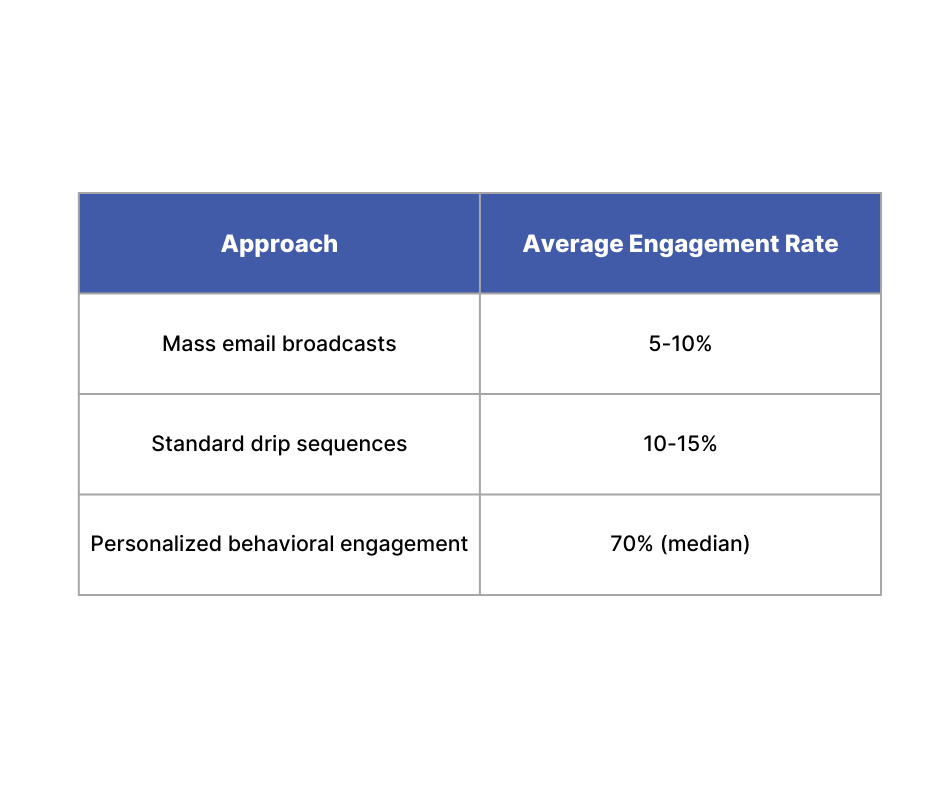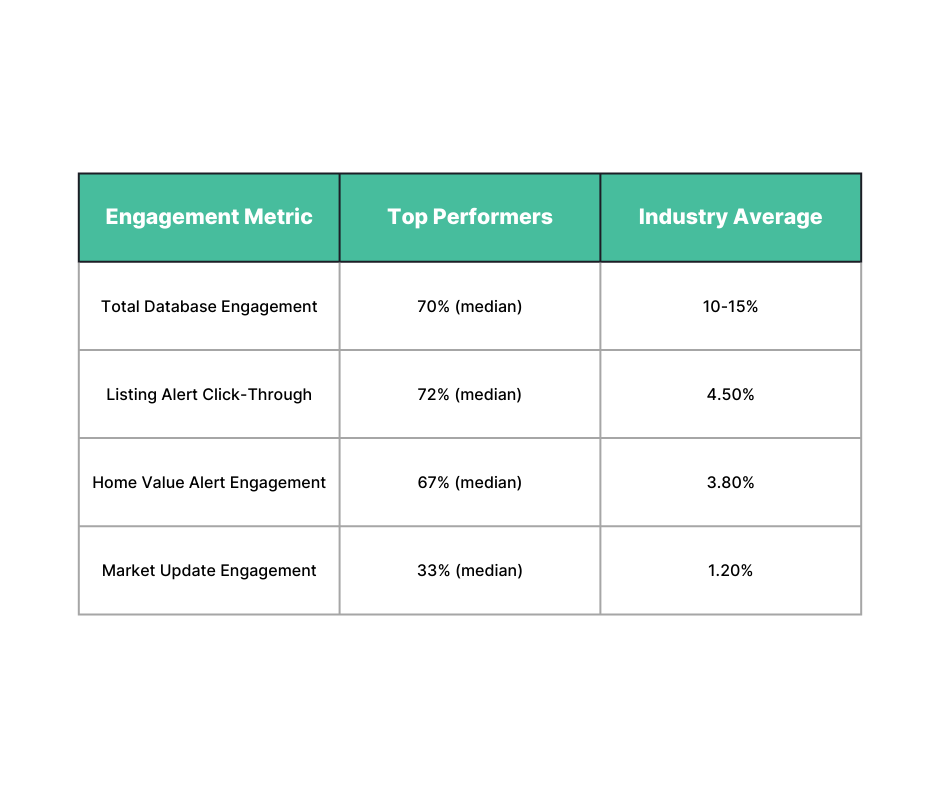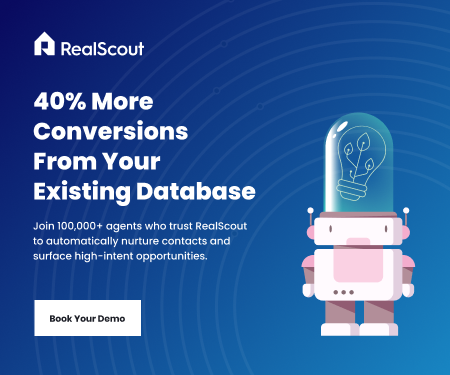Most teams face a common challenge: thousands of leads collected over the years sitting dormant in their CRM. These aren’t just cold contacts—they represent potential transactions worth hundreds of thousands in commissions slowly slipping through the cracks each year.
The traditional solution? Spend more on lead generation to fill a leaky funnel.
But what if the answer isn’t more leads but better engagement with the ones you already have?
Top-performing real estate teams are achieving 70% or higher database engagement rates, compared to the industry average of just 10-15%, without increasing their marketing spend. Instead, they’re implementing systematic engagement strategies that transform their existing database into a transaction-generating machine.
Let’s explore how they’re doing it.
Key Takeaways
- Top teams achieve 70% database engagement by activating existing contacts, not chasing new leads
- Track specific buying behaviors instead of arbitrary timeframes to identify ready-to-transact leads
- Deliver personalized content based on actual lead behavior, not generic drip campaigns
- Consistently engaging just one lead daily creates 365 meaningful connections annually
- Clear response protocols ensure no high-value opportunity falls through the cracks
The Hidden Cost of Dormant Databases
The average real estate team’s CRM contains between 2,000 and 10,000 contacts. At a conservative estimate of $8,000 commission per transaction and a 2% conversion rate, even a small team is letting $320,000-$1.6 million in potential commissions go unclaimed annually.
The problem isn’t just that leads have gone cold—it’s that potential transactions are waiting to be unlocked from people who once showed interest but slipped through the cracks due to inconsistent follow-up.
“Most teams continue pouring thousands into new leads while ignoring the gold mine already in their database,” says Lee Adkins, Co-Founder of Amplified Solutions and a leading real estate technology strategist. “The most untapped opportunity in real estate today isn’t finding new leads—it’s engaging the ones you’ve already paid for.”
Why Traditional Email Campaigns Fall Short
If you’re like most teams, you’ve tried to solve this problem through:
- Generic mass email blasts
- Complex drip campaigns
- Sporadic manual follow-up when time allows
The results are typically disappointing:

The difference comes down to relevance and timing. Traditional approaches fail because they:
- Rely on arbitrary timeframes instead of actual buying/selling signals
- Treat all leads the same, regardless of their specific interests
- Communicate on the sender’s schedule rather than when leads are actively engaged
- Focus on generalized content instead of property-specific information
The Engagement Framework That’s Changing the Game
High-performing teams follow a different approach. Rather than treating database nurturing as an occasional task, they implement a systematic framework that creates continuous engagement through:
1. Behavioral Tracking Over Timeframes
Instead of categorizing leads by how long they’ve been in the database (a poor indicator of transaction readiness), top teams track specific buying and selling behaviors:
- Multiple property views (3+ views indicates high interest)
- Saved properties (bookmarking for future reference)
- Property comparison activity (actively evaluating options)
- Open house information requests (planning physical visits)
- Home value check activity (considering selling)
These behavioral signals provide far more reliable indicators of intent than arbitrary timeframes that neither agents nor clients consistently understand.
2. Automated Personalization That Scales
The key to achieving 70 % engagement isn’t sending more emails—it’s sending the right content to the right people at the right time.
High-performance teams implement automated systems that:
- Send personalized property alerts based on actual viewing patterns
- Provide market updates relevant to the saved search criteria
- Deliver home valuation information when value-checking behavior is detected
- Follow up on specific property inquiries with additional relevant options
This personalization is impossible to achieve manually but becomes scalable through proper automation.
3. Consistent Response Protocols
Top teams document clear processes that define exactly how to respond to different types of engagement:
- Who receives which leads based on specialization
- Expected response time standards for different signals
- Escalation protocols for high-intent activities
- Communication templates for various scenarios
The goal is to eliminate guesswork by creating consistent protocols that ensure every engagement signal receives appropriate follow-up, regardless of which team member is responsible.
The Results: Engagement Metrics that Drive Revenue
When implemented correctly, this systematic approach delivers measurable improvements:

Kenny Truong, the #1 highest-producing agent at eXp Realty, reports, “This systematic engagement approach is the fastest and most cost-effective way to generate transactions from your CRM.”
Similarly, Melissa Sofia of The Avenue Home Collective generated over $100,000 in GCI simply by leveraging more effective engagement tactics with her existing database.
How to Start: The One-a-Day Method
Implementing a complete system can seem overwhelming, but Lee Adkins recommends starting with what he calls “The Power of One-a-Day Consistency”:
“If you got one person a day engaged and you followed up with them, that snowball effect is incredibly powerful,” advises Adkins. “By reaching out to just one lead daily alongside responding to high-intent signals, you’ll make 365 meaningful connections yearly.”
This methodical approach gives you control rather than feeling overwhelmed, creating a competitive advantage precisely because most agents aren’t naturally wired for consistency.
Initial Implementation Strategy
To begin transforming your database engagement:
- Start with your highest-quality 500 contacts
- Select leads with accurate contact information
- Prioritize recent leads (within 90 days) who have previously engaged
- Include past clients and sphere members with established relationships
- Focus on quality over quantity to establish positive engagement patterns
- Establish behavioral categories
- Property Engagement (active buyers showing intent through browsing)
- Active Research (leads planning physical visits or comparing options)
- Seller Signals (home value checks, neighborhood sale interest)
- Direct Communication (leads actively seeking engagement)
- Create response standards
- Define how quickly different signals require follow-up
- Establish who handles which types of engagement
- Document communication templates for common scenarios
- Measure engagement results
- Track email opens and clicks
- Monitor website visits from nurture campaigns
- Record conversion rates from engagement to appointments
Beyond Reactive to Proactive Lead Management
The shift from reactive to proactive lead management is what separates teams that consistently close 20+ transactions per month from those that struggle with feast-or-famine cycles.
Instead of checking in with leads based on memory or gut feeling, these teams establish a systematic approach, ensuring:
- Every high-intent signal gets an appropriate response
- No opportunity falls through the cracks
- Teams focus energy where it matters most
- Lead follow-up becomes consistent and measurable
The result is a predictable, sustainable growth engine built on the foundation of contacts you’ve already acquired.
The Database Isn’t Dead—It’s Just Been Waiting
Your database isn’t dead—it’s just been waiting for the right system to bring it back to life. With the right engagement framework, your team can achieve 70% database engagement without spending more on marketing or working harder.
While most teams continue chasing new leads, forward-thinking real estate professionals are mining the gold already in their database through systematic engagement that delivers the right message to the right lead at the right time.
Ready to transform your team’s database engagement? Download our comprehensive Lead Nurture Mastery guide to discover the complete framework for reviving dormant leads and creating a consistent transaction engine from your existing CRM.






